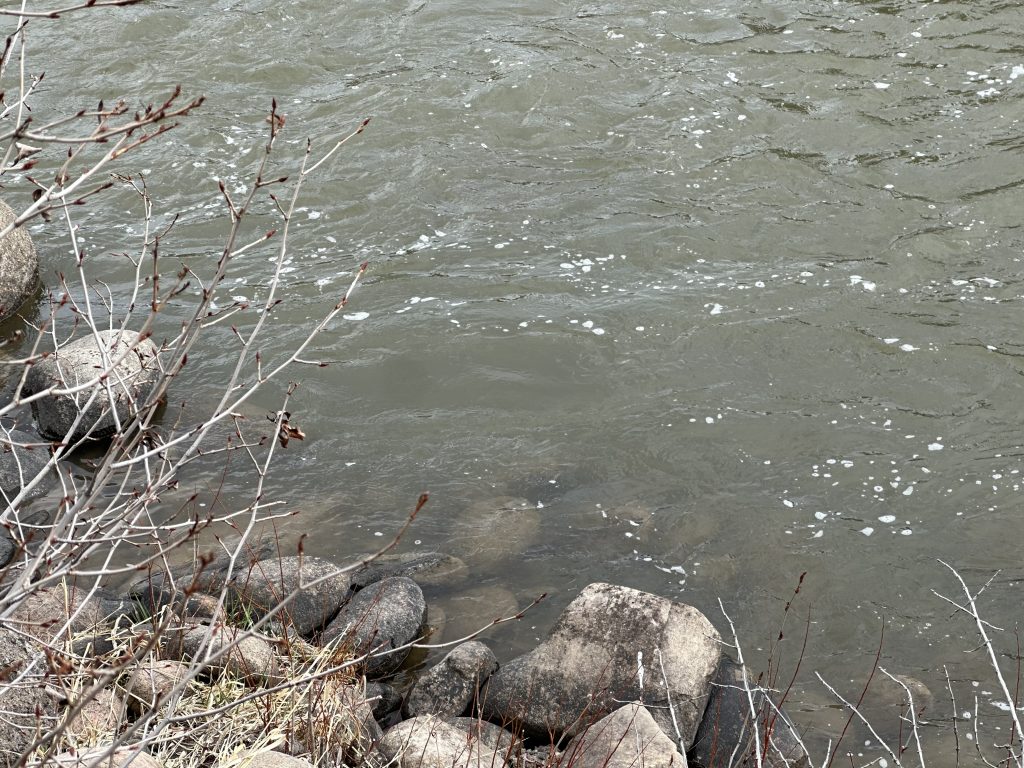Salomone: Targeting the margins.
When targeting turbid water, success comes down to approach and presentation

Michael Salomone/Courtesy photo
Color has swept through the lower Eagle River, changing the game for fly anglers. Negotiating this challenge takes a deliberate focused approach for anglers to achieve success. Targeting a specific depth, current type or proximity to the bank presents your flies where the color thins, bugs are active and fish are feeding.
It’s time to target the margins.
The river conditions feel like pre-runoff, but the recent snowstorm has reminded us that it really shouldn’t be spring, not just yet. Regardless, the push of melt that has colored the river is an obstacle to overcome.

When I speak of how the “color thins,” I mean the turbidity in the river is at a point where visibility is possible. This color allows water to warm more rapidly in the sunshine than the surrounding water; fish can see food sources more easily and anglers can recognize the area to target.
Observing the water reveals the soft, thin color along the margins of the river, mainly the banks. Color thins in shallow water, too. Deciphering the depth and pace where the river grows favorable is the goal.

Support Local Journalism

Water becomes favorable around rocks and large boulders as well. When pace is divided by a barrier, fish will feed in the currents pushed off the obstacle and rest in the eddy formed behind. Any small current presents a situation anglers can exploit. Trout will gravitate to these types of locations; anglers need to recognize the same.
Soft foam lines gather insects. Whether it is emerging nymphs, drowned adults or spent, dead bugs, the foam is a visual indicator anglers can easily decipher. Positioning for a well-managed cast-and-drift becomes key. It isn’t good enough to just get it out there. Presentation is key to success. Mending skills enhance your chances. Mending to eliminate the negative effects of surface currents extends your effectiveness.
Merely tossing out a Blue Wing Olive (BWO) dry fly and letting it swing across the surface or get pulled under the water has very little chance of fooling a trout. But, switching out a dry fly for an emerger or nymph such as a Soft Hackle Pheasant Tail makes the swing an integral component and effective presentation. The BWOs are growing increasingly more active.
Up the size of your subsurface flies in colored water. An effective size 16 nymph in clear water benefits from sizing up to a size 14 or 12. This is where the margins become an asset rather than a hardship. Fish will feed in the margins. Nymphs that possess a larger silhouette attract attention.
Using two different sizes of the same insect is an interesting experiment to conduct in determining which size the fish are more willing to eat. The larger nymph creates a bigger footprint and pulls the fish closer to inspect the fly. The fish then eats the smaller, more natural size nymph as a compulsive reaction.
When anglers fish a dry and dropper rig, shallow water turbidity creates a compulsory situation as well. Shallow water with slight color allows fish to still see and locate the dry and follow a subsurface nymph that now appears to be emerging or tumbling along in the river currents. Proximity to the surface makes both flies attractive while masking less-than-perfect presentations.

Tailouts create a situation where deep water grows shallow before entering the next series of riffles or fast water. Water with color presents a hazard for wading in the deep and cloudy conditions but in the tailout, the river becomes more shallow and the water gets increasingly more friendly. Tailouts make for easier wading on anglers and easier feeding for trout.
Tailouts are a great location where swinging a nymph across the river course or allowing the nymph to swing toward the surface at the end of a drift become favorable tactics. While the main channel of the run will hold fish down deep, the corners of the tailout will produce more. By the corners, I mean the sides of the tailout along the bank before the next fast water. This area holds subtle pace, lighter color and bug activity that is easier for trout to exploit.
Anglers who embrace turbid water can achieve success with a deliberate approach. Focusing on the areas where color in the water grows thin is the objective area. Proper presentation is always a key factor. Despite challenging conditions, anglers are set up for success when they target the margins.





